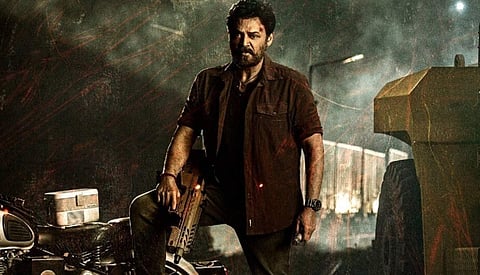Saindhav Movie Review: An action entertainer capsized by sentimentality
Rating:(2 / 5)
When we learn that Saindhav’s (Venkatesh Daggubati) daughter Gayatri (Ssara Palekar) is diagnosed with late-stage Spinal Muscular Atrophy, he is asked by the doctor to go to an NGO. The NGO to take care of SMA patients, which also has enough beds and medical facilities to qualify is titled…SMA NGO. For the large part, this one tiny example, where the film is satisfying with simplistic, skin-deep detailing is emblematic of the larger storytelling that plagues the better part of Saindhav's runtime. Saindhav is ambitious in scale and indulgent in worldbuilding— its writer-director even goes ahead to name his protagonist Saindhav Koneru/SaiKo — an approximate replication of his name Sailesh Kolanu. The film primarily aims to combine old-school sentimentality with new-age action. The results are middling, to say the least, failing to satisfy the viewer on either counts.
Director - Sailesh Kolanu
Cast - Venkatesh Daggubati, Nawazuddin Siddiqui, Baby Ssara Palekar, Shraddha Srinath, Andrea Jeremiah, Ruhani Sharma, Jayaprakash, Arya
One of the biggest factors that sets Saindhav apart from your average-joe actioner is its location, Chandraprastha. Described as a coastal town in South India, the makers of the film design a city with a distinct texture, fertile for the most liberal of narrative possibilities to emerge and run amok. The makers of the film have shot Saindhav in Hyderabad, Vizag, Mumbai and Sri Lanka, creating a multi-layered, spatial mosaic of cultural influences. While a Buddhist stupa is visible in the background of a beach, a fort built by erstwhile Muslim rulers is a location of choice for a cartel’s meeting. In one moody scene, Saindhav travels up the hills to go to an old-school manor to strike a deal with an unlikely ally. Chandraprastha adds an element of novelty and fascination to Saindhav at large, providing the viewer with newer ways of looking at a set of places we have already seen before. This effect, however, does not translate for the film at large, as a handful of the usual suspects cobbled together, be it a father-daughter relationship, the Baasha-Indra trope of a feared, formidable leader of the past finding himself in a working-class job in the present or a high-stakes life and death conflict, do not give us a film that has rightfully earned its stripes by providing a fresh perspective to the audience.
The newer elements, or rather, what comes across as novel in Saindhav, when compared to other films of this genre, is the way it riffs off with a progressive tonality with respect to its characters. Manognya (Shraddha Srinath, who is equal parts endearing and dignified) is Saindhav's neighbour and Gayathri’s self-anointed foster mother. Mano and Saindhav’s relationship has an easy, lived-in quality. Their love life, if you could call it that, revolves around taking care of Gayathri. This is a relief, considering the age-gap between Venkatesh and Shraddha Srinath. Sailesh himself brings this awareness out, in a conversation between the characters. A series of small steps make Mano, and in extension, Sailesh Kolanu’s writing, stand out. She is portrayed as a divorcee, a survivor of domestic abuse and a taxi driver. It is not just the details that grab one’s attention, but the ease and matter-of-factness with which they exist. This was also something we saw in the way the relationship between Adivi Sesh’s and Meenakshi Chaudhary’s characters in HIT: The Second Case were treated.
A star vehicle invariably is a creative marriage between the service a director can do to a star’s image and the service a director can do to his own voice and sensibilities. While Sailesh puts an assured front when it comes to meeting the latter requirement, the former leaves a lot to be desired. A large part of the film deals with rivalry between a cartel responsible for a host of spurious activities, including drug trade and the trafficking of teen mercenaries, en masse, to third-party fundamentalist groups like ISIS and Hamas. This is where the film's facade cracks. The children here, as well as the group of children suffering from SMA, are the designated victims, who merely exist to pave a path for the titular protagonist to transform into a saviour. The countless youth in the story feature in both the old-school and new-age portions of the film, and form the heart of Saindhav's conscience. But, multiple tonal inconsistencies persist. It does not help that the relationship between Saindhav and Gayathri itself comes off as generic. Then we get some throwaway details on how Saindhav left his job as a deadly hitman for a cartel. While Saindhav's action sequences are designed with touches of gore — with knives going through the head vertically and bullets entering from the mouth and exiting from the rear — we also get an overly moralistic explanation early on in the film on how teen boys grow up with bloodlust due to video games. How does the same film blame video games for rising violence, while also displaying graphic violence, obviously designed for the audience’s pleasure and 'mass highs'? Isn't this juxtaposition ironic, considering the fact that the same society that declares video games as a bad influence, also puts violence in cinema in the very same category? Saindhav, the film, goes to great lengths to advertise its morality. Saindhav, the character, is seen bashing up a band of young boys, but not before shooing them away, and yelling at them to go to school. He refuses to hit Jasmine (Andrea Jeremiah), the antagonist’s badass sidekick, saying he does not want to break his track record of never laying a hand on women. In another scene, he does manage to do physical harm to Jasmine, of course, without touching her, without breaking his precious track record. Again, why should a ruthless assassin also be a respectable feminist at the same time? This element was obviously added to show Venkatesh in a shining light. But after a point, it truly feels like an overkill. The last few scenes carry this inconsistency and relentless moralizing to a fever pitch, till we are left feeling nothing. Saindhav never takes off after these misfires, leaving the audience with a thoroughly underwhelming experience.

